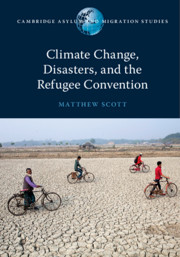Book contents
- Climate Change, Disasters, and the Refugee Convention
- Cambridge Asylum and Migration Studies
- Climate Change, Disasters, and the Refugee Convention
- Copyright page
- Contents
- Figures
- Series Editor’s Preface
- Acknowledgements
- Note on the Text
- Table of Cases
- Table of Treaties and Other International and Regional Instruments
- Abbreviations
- 1 Introduction
- 2 Two Disaster Paradigms
- 3 Jurisprudence on the Determination of Refugee Status in the Context of ‘Natural’ Disasters and Climate Change
- 4 Interpreting the Refugee Definition
- 5 The Temporal Scope of Being Persecuted
- 6 The Personal Scope of Being Persecuted: The Function of the Non-discrimination Norm within the Refugee Definition
- 7 Refugee Status Determination in the Context of ‘Natural’ Disasters and Climate Change
- Appendix: Taxonomy
- Bibliography
- Index
1 - Introduction
Published online by Cambridge University Press: 18 January 2020
- Climate Change, Disasters, and the Refugee Convention
- Cambridge Asylum and Migration Studies
- Climate Change, Disasters, and the Refugee Convention
- Copyright page
- Contents
- Figures
- Series Editor’s Preface
- Acknowledgements
- Note on the Text
- Table of Cases
- Table of Treaties and Other International and Regional Instruments
- Abbreviations
- 1 Introduction
- 2 Two Disaster Paradigms
- 3 Jurisprudence on the Determination of Refugee Status in the Context of ‘Natural’ Disasters and Climate Change
- 4 Interpreting the Refugee Definition
- 5 The Temporal Scope of Being Persecuted
- 6 The Personal Scope of Being Persecuted: The Function of the Non-discrimination Norm within the Refugee Definition
- 7 Refugee Status Determination in the Context of ‘Natural’ Disasters and Climate Change
- Appendix: Taxonomy
- Bibliography
- Index
Summary
The introductory chapter presents the view, widely reflected by legal academics, UNHCR and senior judiciary in leading refugee law jurisdictions, that the Refugee Convention has very limited relevance to displacement across borders in the context of disasters and climate change. Some key examples of this perspective are presented and a connection is made between the expression of this view and what the book terms the ‘hazard paradigm’ to understanding disasters. The chapter notes that much of the jurisprudence reflecting the hazard paradigm has relied upon disasters as an aid to articulating the scope of the refugee definition. The argument is advanced that the critical analysis of epistemological and doctrinal assumptions underpinning this 'dominant view' helps to clarify the contours of the refugee definition in general, as well as in the specific context that is the focus of the book.
- Type
- Chapter
- Information
- Publisher: Cambridge University PressPrint publication year: 2020

